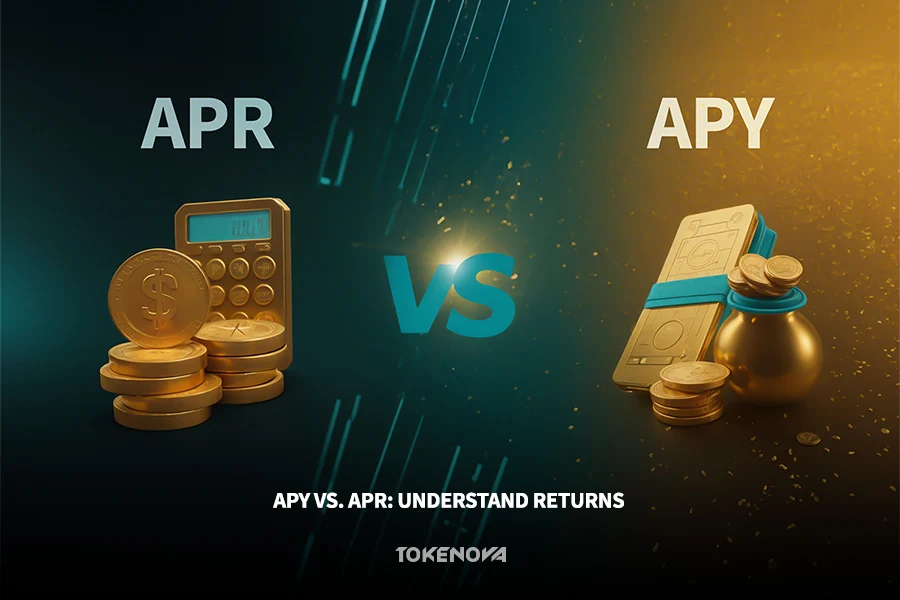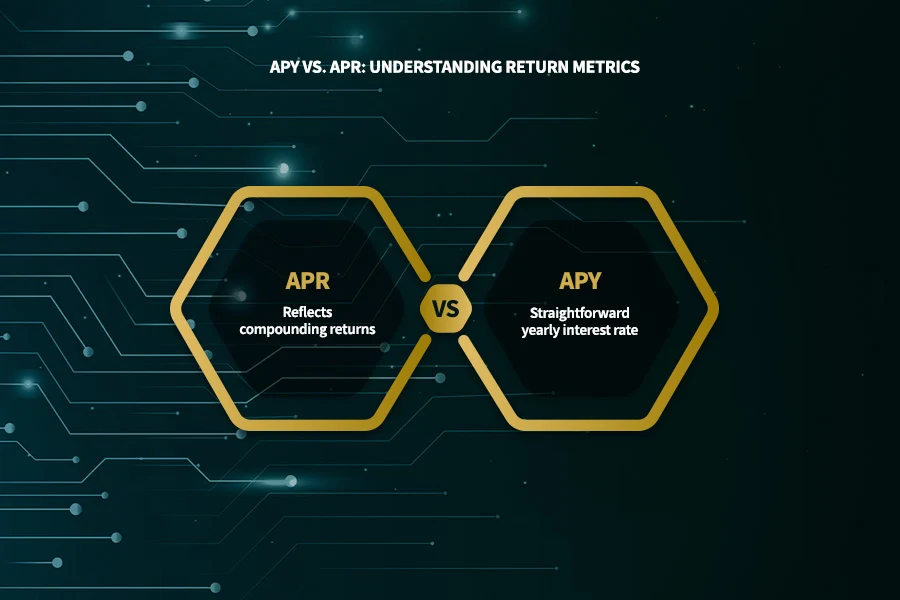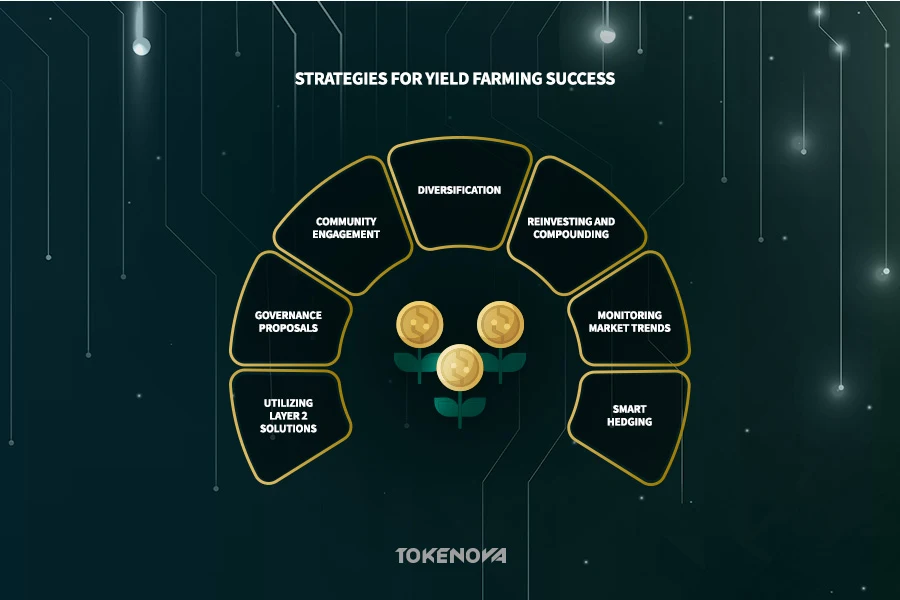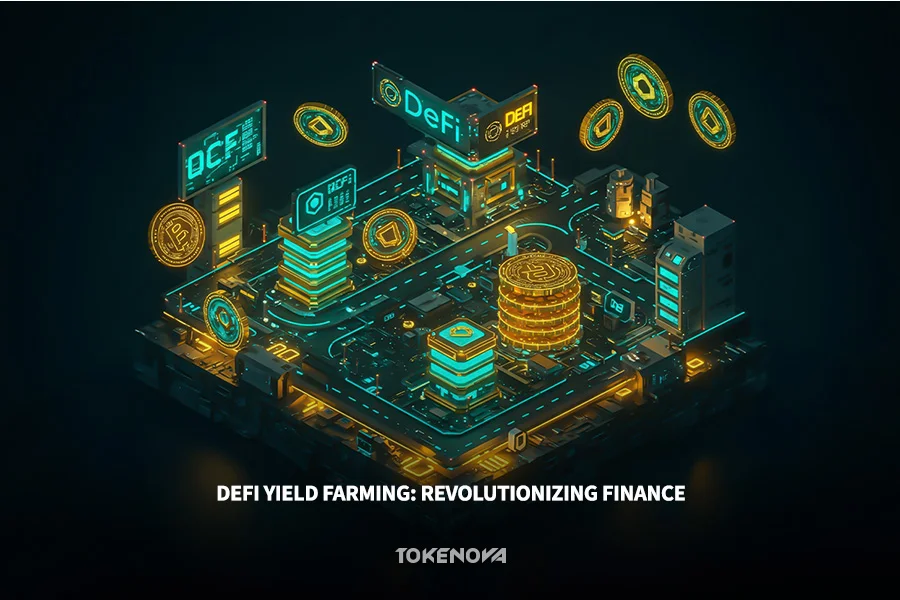What if you could earn generous returns on your crypto assets simply by contributing them to decentralized financial protocols? That is precisely what Yield Farming in DeFi offers—a groundbreaking way for investors to put their cryptocurrency to work and, in many cases, reap substantial rewards. In essence, the process involves lending or staking digital assets in a variety of decentralized finance ecosystems to earn additional cryptocurrency. Right from the start, it delivers on its promise: providing an opportunity for lucrative gains in the emerging world of decentralized finance.
But how does it differ from conventional banking systems, and why is it a game-changer? Traditional finance relies on intermediaries—banks, brokers, and financial institutions. They set the rules, take their cut, and pass on a fraction of the profits (if you’re lucky) to depositors. In DeFi Yield Farming Strategy, you become the bank, the liquidity provider, and the key beneficiary of the system’s growth. With no middleman in the way, your returns can be significantly higher than the meager interest rates offered by legacy banks.
If you’re curious, cautious, or even a little skeptical about the hype surrounding decentralized finance, this blog post is your roadmap. We’ll demystify the workings of yield farming, explore How to Start Yield Farming in DeFi, evaluate the best platforms for yield farming in 2025, and dive deep into the compelling yet complex world of DeFi strategies. We’ll also uncover the potential pitfalls—yes, there are risks—and highlight ways to mitigate them.
Understanding Yield Farming in DeFi
Before diving into specific strategies, it’s crucial to understand the fundamentals of Yield Farming in DeFi. This section introduces the concept and its importance within the broader DeFi ecosystem.

Definition and Overview
At its core, yield farming involves locking up your cryptocurrency in liquidity pools or smart contracts to facilitate lending, borrowing, or trading. As a reward for contributing your assets, you receive yields in the form of interest payments, governance tokens, or additional cryptocurrencies. While the concept of earning a yield on your idle assets isn’t new—think of savings accounts—the approach taken by DeFi protocols reshapes what’s possible. Instead of banks reaping most of the profits, these decentralized systems distribute rewards back to the community of liquidity providers.
Importance in the DeFi Ecosystem
In the DeFi universe, yield farming serves as a linchpin. Decentralized exchanges (DEXs), lending platforms, and trading protocols need deep liquidity to function. That’s where yield farmers come in. By locking up funds, yield farmers bring vital liquidity to these protocols, thereby increasing their efficiency and stability. This synergy bolsters DeFi’s ability to challenge traditional finance.
Meanwhile, yield farmers stand to benefit from potentially high annual percentage yields (APYs)—some protocols have even boasted triple- or quadruple-digit returns during peak market conditions. Of course, these astounding yields come with commensurate risks, but for many investors, the allure of high rewards is irresistible.
Comparison to Traditional Financial Systems
Traditional systems typically offer nominal interest rates on savings, often less than 1% annually in many countries. Banks and financial institutions make significant profits by lending out customer deposits at higher rates, while depositors receive a fraction of the revenue. In DeFi, smart contracts replace these traditional intermediaries. Protocols like Aave, Compound, and Curve Finance handle lending and borrowing automatically, governed by transparent rules on the blockchain.
Because overheads and middlemen are minimized, the share of profits that returns to liquidity providers is usually higher. Moreover, yield farmers can switch between multiple protocols to chase the best returns, adding a layer of dynamism absent in the traditional system.
A Growing Force
To understand the magnitude of this shift, consider the total value locked (TVL) in DeFi protocols. While exact figures fluctuate with market movements, the Total Value Locked (TVL) across multiple DeFi blockchains reached approximately $120 billion, approaching the ecosystem’s all-time high of around $175 billion in 2021. This capital inflow underscores increasing trust and optimism in the DeFi space.
What’s even more remarkable is the global nature of DeFi. It’s open to anyone with a crypto wallet, turning the age-old, exclusive realm of finance into a borderless, democratic playground. With yields often surpassing anything found in the traditional sphere, Yield Farming in DeFi has left institutional and retail investors alike with raised eyebrows and heightened excitement.
Decoding How Yield Farming Works
To effectively engage in DeFi Yield Farming Strategy, it’s essential to understand the underlying mechanisms. This section breaks down the key components that make yield farming possible.
Liquidity Pools and Automated Market Makers
Traditional exchanges match a buyer’s order with a seller’s order. However, decentralized finance introduced AMMs, which use algorithms within liquidity pools to price assets. Here’s how it works:
Liquidity Pools: These are collections of funds locked in a smart contract. For example, if a platform has a pool of ETH and USDT, anyone can contribute to that pool. When traders swap ETH for USDT or vice versa, the liquidity pool facilitates the trade.
Automated Market Makers (AMMs): AMMs determine the price of the assets in the pool using mathematical formulas. One popular formula is xy = k* (the product of the quantities of the two tokens must remain constant). This model ensures that the pool always has liquidity for trades—although large trades can significantly change the price ratio of the tokens in the pool.
This mechanism is extraordinary because it avoids the need for an order book, effectively democratizing liquidity provision. Every liquidity provider has a share in the pool and gains a fraction of the fees from traders who use that pool.
Role of Liquidity Providers and Their Rewards
Liquidity providers (LPs) deposit their tokens into these pools, effectively staking their assets in the platform. In return, they receive LP tokens representing their share of the pool. When traders execute swaps, they pay a fee—often around 0.2% to 0.3% of the trade amount. That trading fee is then distributed among all liquidity providers relative to their share in the pool.
Beyond trading fees, many protocols encourage liquidity provision by offering additional incentives, commonly known as yield farming rewards. For instance, a protocol might distribute governance tokens to LPs. These tokens may appreciate in value, adding another layer of potential profit.
Smart Contracts: The Engine of Yield Farming
Smart contracts are self-executing agreements coded onto the blockchain, typically Ethereum or other networks like Binance Smart Chain, Polygon, or Arbitrum. They run automatically when certain conditions are met. This automation underpins nearly all aspects of DeFi, including:
Distribution of Rewards: Smart contracts dictate how yield farming rewards are dispersed among LPs.
Security: Ideally, if the smart contract is secure, it reduces the need for third-party oversight.
Programmable Logic: This allows for complex maneuvers like multi-step yield farming strategies and yield aggregators that automatically optimize user returns.
In effect, smart contracts serve as the neutral, incorruptible middleman that ensures yield farmers receive fair, transparent rewards. While the code is vulnerable to exploitation if not audited correctly, the overarching principle remains a powerful innovation in finance.
Exploring Types of Yield Farming Strategies
The world of DeFi offers a diverse array of yield farming strategies, each designed to suit different levels of risk tolerance and expertise. In this section, we will explore a variety of these strategies, moving from simpler, more accessible options to those that are more advanced.

Liquidity Provision
Renowned Protocols: Uniswap, Curve Finance, PancakeSwap
Mechanics: Liquidity provision involves depositing a pair of tokens, for instance, ETH and USDC, into what’s known as a liquidity pool. These pools operate using an Automated Market Maker, or AMM, which allows traders to seamlessly swap between the two tokens in a decentralized manner.
Pros: One of the primary advantages of liquidity provision is the opportunity to earn trading fees. As traders utilize the pool, a small fee is generated from each transaction, and this is distributed proportionally to those who have provided liquidity. Furthermore, platforms often incentivize liquidity providers by rewarding them with native or governance tokens, in addition to the trading fees, potentially boosting your overall returns.
Cons: It’s crucial to be aware of the potential for impermanent loss. This can occur if the price of the deposited tokens diverges significantly in either direction, which can reduce the value of your deposited assets compared to simply holding them. Additionally, the returns can fluctuate depending on the trading volume within the pool; higher volume generally translates to higher fee earnings, but this is not guaranteed.
Liquidity provision stands out as a relatively straightforward entry point into yield farming, particularly appealing for individuals who already possess a diversified portfolio of cryptocurrency holdings. Its user-friendly nature on platforms like Uniswap and Curve Finance also makes it an excellent starting point for anyone looking to understand How to Start Yield Farming in DeFi.
Staking
Renowned Protocols: Ethereum (ETH 2.0 staking), Rocket Pool, Lido, Ether.fi
Mechanics: Staking involves locking up your tokens to actively support the security and operational integrity of a blockchain network. By participating in staking, you contribute to the network’s consensus mechanism, and in return, you are rewarded, typically in the form of newly minted tokens or a share of transaction fees.
Pros: Generally, staking is considered to be more stable and less risky when compared to liquidity provision. It often provides a more predictable form of passive income, as staking rewards are typically distributed on a regular schedule.
Cons: A key consideration is that your funds are usually locked and inaccessible for a predetermined period, which means you cannot readily access or trade these assets during the staking duration. Furthermore, while staking itself might be less risky than other strategies, you are still exposed to the potential for volatility in the token’s market price. If the value of the staked token decreases, your overall returns can be affected.
Within the broader DeFi landscape, staking can serve as a less intimidating starting point for those who might find the complexities of liquidity pools daunting. Moreover, innovative projects like Lido and Ether.fi have introduced the concept of “liquid staking.” This allows you to stake your tokens while simultaneously receiving derivative tokens that represent your staked position. These derivatives can then be used to participate in other yield farming opportunities or trading activities, maintaining liquidity even while your assets are staked.
Leveraged Yield Farming
Renowned Protocols: Alpha Homora, Alpaca Finance
Mechanics: Leveraged yield farming takes the concept of liquidity provision a step further by allowing you to borrow additional tokens to amplify your stake in a liquidity pool. This strategy essentially magnifies both your potential gains and, importantly, your potential losses.
Pros: The primary allure of leveraged yield farming is the potential for significantly higher yields compared to basic liquidity provision, especially when market conditions are bullish and prices are trending upwards.
Cons: It is essential to understand that leveraged yield farming comes with increased risk. A sudden downturn in the market could trigger liquidations, where your borrowed funds and initial stake are automatically sold to repay the loan, potentially resulting in substantial losses. Furthermore, an impermanent loss is also magnified due to the larger position size created by leverage, meaning price divergences can have a more pronounced negative impact.
Leveraged yield farming is most appropriately suited for experienced users who possess a deep understanding of market dynamics and robust risk management strategies. It shares similarities with margin trading in traditional finance – potentially highly lucrative when executed correctly, but potentially catastrophic if approached without caution and expertise.
Yield Aggregators and Auto-Compounding
Renowned Protocols: Yearn.finance, Beefy Finance, Harvest Finance
Mechanics: Yield aggregators are platforms designed to automatically navigate the landscape of yield farming opportunities to maximize your returns. These platforms intelligently move your funds across various protocols and strategies, seeking out the most profitable options at any given time. They also typically incorporate auto-compounding, which means your earned gains are automatically reinvested back into the strategy, periodically compounding your returns.
Pros: Yield aggregators offer a hands-free approach to yield farming. The protocol itself handles much of the complex and time-consuming work of identifying and optimizing yield opportunities. Due to this constant optimization and automated strategy switching, they can often achieve higher yields than manual strategies that require constant monitoring and adjustments.
Cons: A crucial consideration is the introduction of additional smart contract risks. When using a yield aggregator, you are entrusting your funds to the aggregator’s smart contracts, and it’s vital to assess the security and audit history of these contracts. Additionally, performance fees are often charged by yield aggregators, which can, to some extent, reduce your overall profits. These fees are typically a percentage of the yield generated by the platform.
For individuals seeking a more passive approach to yield farming that still aims to capture the most attractive DeFi yields, yield aggregators present a compelling option. You simply deposit your tokens, and the protocol’s automated vaults then work continuously to optimize your returns.
Which Strategy is Right for You?
Ultimately, the selection of a DeFi Yield Farming Strategy should align with your individual risk appetite and level of expertise.
Beginner: If you are new to yield farming, it is advisable to start with staking or simple liquidity pools involving stablecoin pairs, such as DAI-USDC. Stablecoins are designed to minimize volatility, making these options less susceptible to drastic price swings.
Intermediate: As you gain experience and comfort, you might consider experimenting with liquidity pools of more volatile token pairs. Alternatively, you could explore partial exposure through yield aggregators, allowing you to benefit from automated optimization while still maintaining some control over your strategy.
Advanced: For those with a strong understanding of DeFi and risk management, leveraged yield farming can be explored. However, it is paramount to approach this strategy with robust risk management practices in place and a thorough comprehension of market dynamics.
Regardless of your chosen entry point, it is always essential to carefully assess your financial goals, risk tolerance, and investment time horizon. The DeFi space is characterized by rapid evolution, and prioritizing established, well-audited platforms can significantly enhance your security and peace of mind as you navigate this exciting landscape.
Understanding Key Metrics in Yield Farming
To truly thrive in the world of DeFi Yield Farming, it’s essential to not just participate, but to actively monitor and understand the key performance indicators that drive success. This section will illuminate the crucial metrics you need to evaluate yield farming opportunities effectively.

APY vs. APR: Understanding Return Metrics
When assessing potential returns, you’ll frequently encounter two terms: APR (Annual Percentage Rate) and APY (Annual Percentage Yield). It’s vital to grasp the distinction between them. APR represents the straightforward yearly interest rate, calculated without considering the effects of compounding. For example, if a liquidity pool advertises a 15% APR, this means you would earn precisely 15% of your initial deposit over a year, assuming consistent conditions and no compounding.
APY, on the other hand, takes compounding into account. Compounding refers to the process of reinvesting your earned rewards, so they too can generate further returns. If a protocol compounds your earnings multiple times throughout the year – daily, for instance – the effective return you achieve will surpass the base APR. So, that same 15% APR, when compounded regularly, could translate into an APY of, say, 18% or even higher, reflecting the power of reinvested earnings.

Let’s consider a real-world example to illustrate this. Imagine you deposit $1,000 into a DeFi protocol offering a 20% APR. If this protocol employs auto-compounding of earnings on a daily basis, your actual return over a year wouldn’t be a simple 20%. Instead, due to the daily compounding effect, your realized return could climb to approximately 22-23% APY. Therefore, it’s always prudent to carefully check whether platforms are quoting APR or APY to get a truly accurate picture of the potential returns you can expect.
Impermanent Loss: Navigating a Key Risk
One of the most significant and unique risks inherent in yield farming, particularly within liquidity pools, is impermanent loss. This phenomenon arises when the price of one token in a liquidity pair changes relative to the other. Because Automated Market Makers (AMMs) are designed to maintain a constant product within the pool, the system automatically adjusts the ratio of the two tokens to reflect these price changes.
When does impermanent loss occur? It happens when the prices of the tokens in your pair diverge significantly. In such scenarios, the AMM mechanism will rebalance the pool, potentially leaving you with more of the token that has decreased in value and less of the token that has appreciated.
Why is it termed “impermanent”? The term “impermanent” is used because this loss is not necessarily permanent until you withdraw your liquidity. If, at some point in the future, the token prices were to revert back to their original relative levels at the time of your deposit, this “loss” would effectively disappear. However, if you choose to withdraw your liquidity while the price divergence persists, the loss becomes realized and therefore, permanent.
While the trading fees and farming rewards you earn as a liquidity provider can often partially offset impermanent loss, it remains a crucial consideration, especially when dealing with volatile token pairs. One effective strategy to mitigate impermanent loss is to provide liquidity to stablecoin pairs, such as DAI-USDC. Because stablecoins are designed to maintain a stable value, price divergence between them is typically minimal, thus reducing the risk of impermanent loss.
Total Value Locked (TVL): Gauging Platform Health
Total Value Locked (TVL) is a widely used metric in DeFi that represents the aggregate value of all crypto assets currently deposited within a particular DeFi protocol. A higher TVL generally suggests several positive attributes. Firstly, it often indicates greater liquidity and stability within the protocol, as a larger pool of assets is available for trading and other operations. Secondly, a high TVL can be interpreted as a sign of increased trust and adoption among users, as it reflects a significant amount of capital entrusted to the platform.
However, it’s important to note that a higher TVL does not automatically guarantee higher yields. In some cases, as more users are attracted to a protocol and deposit assets, the yields can actually diminish. This is because rewards are often distributed proportionally among liquidity providers, and a larger pool of providers can dilute individual rewards. Nevertheless, TVL remains a valuable indicator of a platform’s overall health and popularity, providing a useful snapshot of its current standing in the DeFi ecosystem.
Putting It All Together: Strategic Decision Making
By diligently monitoring APY, thoroughly understanding impermanent loss, and keeping a close watch on TVL, yield farmers can significantly refine their strategies and make more informed decisions. Within the context of Best Yield Farming Strategies in DeFi, these metrics serve as essential guiding lights, helping you navigate the ever-changing and often complex DeFi landscape. It’s simply not enough to be swayed by advertised double-digit or even triple-digit APYs alone. A truly effective yield farming approach requires a holistic perspective, taking into account market movements, inherent risk factors, and the long-term sustainability of the protocols and strategies you choose to engage with.
Read More: The Utility Token of a Decentralized Lending Platform
Navigating Risks and Challenges in Yield Farming
While DeFi Yield Farming offers high returns, it presents risks requiring careful management. This section outlines key risks and concise mitigation strategies for 2025.
1. Smart Contract Vulnerabilities
Smart contract flaws can lead to major losses, and exploits remain a persistent threat despite security improvements in DeFi.
Mitigation: To mitigate smart contract risks, prioritize platforms that have undergone audits by reputable security firms such as CertiK or PeckShield. Favor protocols that operate strong bug bounty programs to incentivize vulnerability discovery. Consider utilizing insurance options from providers like Nexus Mutual or InsurAce to protect against potential losses. Finally, it is advisable to choose platforms that implement real-time threat monitoring systems, ideally powered by AI, for enhanced security vigilance.
2. Market Volatility
Crypto markets are inherently volatile. Price crashes can significantly devalue deposited assets, and the use of leverage in yield farming amplifies the risk of liquidation.
Mitigation: Effective mitigation of market volatility involves several key strategies. In leveraged farming, diligently maintain safe collateralization ratios to stay well above liquidation thresholds. Diversify your asset holdings by spreading investments across stablecoins, established blue-chip cryptocurrencies like ETH and BTC, and carefully selected altcoins. For a lower volatility approach, consider focusing on stablecoin farming within pools like USDC/DAI, which offer more stable returns.
3. Impermanent Loss
Impermanent loss, caused by token price divergence in liquidity pairs, can reduce profitability for liquidity providers and remains a challenge, especially in volatile markets.
Mitigation: To minimize impermanent loss, consider utilizing stablecoin pools composed of pairs like USDT/USDC or DAI/USDC, which inherently reduce price divergence. Explore dynamic hedging strategies using options, perpetual swaps, or specialized DeFi hedging platforms such as Hegic or Lyra to actively counteract potential losses. Furthermore, consider leveraging auto-rebalancing protocols offered by platforms like Balancer or yield aggregators, which optimize pool allocations to minimize impermanent loss exposure.
4. Regulatory Risks
The evolving regulatory landscape for DeFi presents risks as stricter oversight in various jurisdictions could impact accessibility and introduce complex compliance requirements.
Mitigation: To navigate regulatory risks, it is crucial to stay updated on regulatory news and developments in your region through reliable sources like CoinDesk, CoinTelegraph, and government publications. When selecting platforms, prioritize those that are established and actively working towards regulatory compliance, such as Aave, MakerDAO, and Uniswap. For personalized guidance, consult with legal and financial experts who specialize in the cryptocurrency and DeFi space to ensure full compliance with local regulations.
5. Liquidity Risks
Fund lock-up periods, common in many DeFi protocols, can create liquidity risks by limiting access to capital, particularly during unexpected market downturns.
Mitigation: To manage liquidity risks, carefully understand the lock-up terms of any protocol before participating. Generally, it is prudent to avoid protocols with extended lock-up periods unless the offered rewards are significantly higher and justify the reduced liquidity. Diversify your yield farming strategies by combining long-term locked positions with more liquid, shorter-term opportunities. Maintain emergency reserves of highly liquid assets that can be quickly accessed and redeployed if needed.
6. Psychological Pressure
The fast-paced and high-stakes environment of DeFi can create significant psychological pressure, potentially leading to emotional decision-making driven by FOMO or FUD, which can result in poor investment choices.
Mitigation: To mitigate psychological pressures, define clear investment goals, setting realistic profit targets and risk limits before investing. Conduct thorough research on protocols and strategies to reduce uncertainty and impulsive reactions. Take regular breaks from market monitoring to maintain clarity, perspective, and avoid becoming overly emotionally invested in short-term market fluctuations.
7. Emerging Risk: Cross-Chain Issues
The rise of multi-chain farming introduces emerging risks related to cross-chain interoperability, including bridge hacks and inconsistencies in security across different blockchain ecosystems.
Mitigation: To address cross-chain risks, utilize only trusted and well-established bridge solutions like LayerZero, Wormhole, or Synapse for cross-chain transactions. Thoroughly verify the security measures of multi-chain platforms, ensuring they have undergone audits and have active security monitoring in place. Limit your exposure by diversifying funds across multiple chains and avoid over-reliance on any single blockchain ecosystem to mitigate the impact of chain-specific vulnerabilities.
Balancing Risk and Reward: Key to DeFi Success
Understanding these risks is paramount for effectively balancing risk and reward in DeFi yield farming. Vigilance, adaptability, and a proactive approach are essential for navigating the dynamic DeFi landscape of 2025 and achieving sustainable success. The following sections will highlight top platforms and strategies for 2025.
Tokenova’s Services: Your Yield Farming Gateway
If you’re seeking a reliable and efficient way to navigate the complexities of DeFi yield farming, Tokenova can serve as your comprehensive solution. Our platform simplifies yield farming through intuitive dashboards, real-time analytics, and robust security features. Imagine a streamlined interface that shows you the most lucrative pools, manages your portfolio with precision, and keeps you informed about new and promising DeFi protocols.
Here’s what sets Tokenova apart:
- Advanced Yield Aggregation: Our algorithm automatically locates high-reward pools across various blockchains, saving you the time and energy needed to research daily.
- Portfolio Management Tools: Monitor your impermanent loss, track your daily APY, and get alerts when market conditions change.
- Expert Support: From risk assessment to regulatory insights, our team of DeFi specialists is available to guide you.
- Multi-Chain Access: Connect your wallets across major networks like Ethereum, Binance Smart Chain, Polygon, and beyond.
Make Tokenova your trusted partner and seize control of your financial future. For more details, Call our experts and embark on a yield farming journey that’s both rewarding and secure.
Insider Secrets for Maximizing Yield Farming Profits
To truly excel in How to Start Yield Farming in DeFi and maximize your returns, consider these insider secrets used by experienced yield farmers.

Diversification Across Platforms and Assets
The golden rule in almost any investment strategy is diversification. Relying too heavily on a single protocol or token can be disastrous if that protocol is compromised or the token’s price tanks.
- Split your capital among different yield farming protocols like Aave, Compound, and Uniswap. Combine stablecoin pools with higher-yield pools to balance risk.
Reinvesting and Compounding
Compounding your earnings accelerates growth. Instead of cashing out your rewards, reinvest them into the same pool or another promising protocol.
- Leverage tools like Yearn.finance or Beefy Finance, which auto-compound your returns. Over time, this small step can significantly enhance overall profitability.
Monitoring Market Trends
DeFi markets move quickly. New platforms emerge, and yields shift as more users pile in. Being aware of these trends is crucial to maximizing returns.
- Follow reputable DeFi analysts on Twitter or Discord. Set up notifications for announcements from protocols you’re invested in. Knowledge often translates into timely decisions.
Smart Hedging
Hedging strategies, such as buying put options or using futures, can protect your assets from downside volatility.
- Assess platforms like Hegic or Opyn for on-chain options trading. If the underlying asset’s price falls, your options contract could offset some of the losses.
Utilizing Layer 2 Solutions
As Ethereum gas fees soared, Layer 2 solutions have seen significant adoption, with platforms like Arbitrum, Optimism, and zkSync offering reduced transaction fees and faster processing times, making them increasingly popular among DeFi users.
- Explore yield farming opportunities on these Layer 2 networks. Lower transaction costs let you compound more frequently, boosting APYs.
Keep an Eye on Governance Proposals
Many DeFi platforms hold governance votes to decide on changes in fee structures, rewards, or strategic partnerships.
- If you hold governance tokens like COMP or AAVE, participate in votes. Proposals can reshape yield rates, so staying engaged lets you anticipate market shifts.
Engage in Research and Community Discussions
Finally, never underestimate the power of community knowledge. Joining Telegram or Discord groups can offer firsthand insights into potential red flags or hidden gem opportunities.
- Ask questions, verify claims, and use multiple sources to cross-check information. Cultivating this habit transforms you from a passive investor into a savvy contributor.
Practicing these insider secrets can give you a competitive edge in the highly dynamic realm of How to Start Yield Farming in DeFi. The next section delves into upcoming trends that could redefine DeFi yield farming, setting the stage for even bigger opportunities—and challenges—on the horizon.
Future Trends Shaping DeFi Yield Farming
The DeFi ecosystem’s relentless evolution positions yield farming at the cutting edge of financial innovation. Looking ahead to 2025, key trends are reshaping investor approaches, presenting both novel opportunities and complex challenges.
Layer 2 Solutions: Scalability Achieved
Layer 2 (L2) networks like Arbitrum, Optimism, and zkSync Era are fundamentally altering DeFi by resolving Ethereum’s scalability limitations.
Reduced Transaction Costs: L2s have dramatically lowered gas fees, democratizing yield farming for smaller capital deployments.
Accelerated Transactions: Enhanced throughput ensures efficient farming and rapid compounding cycles.
Native L2 Protocols: Emerging L2-native protocols such as GMX and Radiant Capital are pioneering fresh yield generation avenues.
L2 proliferation will further decentralize DeFi, extending access to sophisticated yield strategies previously gated by prohibitive costs.
Institutional Ingress: Mainstream Validation
Major financial institutions are increasingly integrating DeFi into their broader digital asset strategies.
Tokenized Real-World Assets (RWAs): Institutions are deploying tokenized assets—stocks, bonds, real estate—into DeFi, creating novel yield landscapes. For example, tokenized real estate enabling rental income streams via DeFi platforms.
Regulatory Harmonization: Institutional engagement is driving demand for regulatory clarity, potentially fostering wider trust and adoption across both retail and institutional segments.
Institutional participation will inject substantial liquidity, enhance credibility, and accelerate innovation within DeFi, albeit potentially accompanied by more stringent regulatory frameworks.
Restaking and Liquid Staking: Capital Efficiency Redefined
Staking is advancing through restaking and liquid staking, optimizing capital utilization and asset flexibility for users.
Liquid Staking: Platforms like Lido and Rocket Pool enable staking while issuing tradable derivatives, usable in further yield strategies.
Restaking: Protocols like EigenLayer allow staked assets to secure multiple networks concurrently, compounding yield potential.
These innovations dramatically improve capital efficiency, enabling investors to stack multiple reward layers while preserving asset liquidity.
Artificial Intelligence (AI) Integration: Algorithmic Optimization
AI-driven tools are becoming essential in DeFi, facilitating smarter and more efficient yield farming methodologies.
Optimized Yield Farming: AI algorithms dynamically analyze market dynamics and autonomously allocate capital to peak-yield pools. For instance, AI platforms like Harvest Finance and Yearn.finance provide real-time yield optimization across protocols.
Proactive Risk Management: Predictive analytics enhance risk mitigation by identifying potential vulnerabilities preemptively.
AI will empower yield farmers with superior decision support, automating complex processes and maximizing returns while minimizing manual intervention.
Cross-Chain Yield Farming: Interoperable Ecosystems
The rise of multi-chain ecosystems is enabling yield farmers to operate seamlessly across disparate blockchains.
Cross-Chain Bridges: Platforms like LayerZero and Synapse facilitate secure asset transfers across chains.
Diversified Opportunities: Farming across ecosystems—Ethereum, Binance Smart Chain, Polygon, Avalanche, Solana—allows users to capture yields from diverse network environments.
Cross-chain farming expands opportunity sets but introduces complexities in bridge security and integrated portfolio management across multiple chains.
Tokenized Real-World Assets (RWAs): Bridging Traditional Finance
The incorporation of real-world assets into DeFi is broadening the spectrum of yield farming instruments.
RWA Examples: Tokenized real estate, commodities, and sovereign debt.
Yield Opportunities: RWAs can be staked or used as DeFi collateral to generate stable, real-world-backed yields.
RWA integration will attract traditional capital and create more stable yield farming avenues, counterbalancing the inherent volatility of purely crypto-native assets.
Sustainable APYs: Long-Term Viability
The unsustainable hyper-yields of early DeFi are transitioning to more moderate and dependable returns.
Stability Focus: Protocols are prioritizing consistent, realistic yields to cultivate long-term user engagement.
Incentive Redesign: Governance tokens are being restructured to provide enduring rewards rather than speculative spikes.
Sustainable APYs will foster long-term DeFi ecosystem growth and reduce the volatility associated with unsustainable, fleeting yields.
Regulatory Developments: Navigating Global Frameworks
Increasing global regulatory scrutiny is evident, with jurisdictions diverging between crypto-supportive policies and stricter controls.
Positive Trends: Nations like Singapore, Switzerland, and the UAE are establishing clear, enabling frameworks for DeFi and yield farming.
Challenges: Restrictive regulations in other regions may limit DeFi accessibility or impose compliance burdens on platforms.
Regulatory clarity will facilitate institutional onboarding but could also lead to regional fragmentation in DeFi access and operational scope.
Security and Decentralized Insurance: Risk Mitigation Imperative
As DeFi scales, security remains paramount.
Enhanced Security Measures: Protocols are implementing robust security architectures: multi-layered audits, bug bounties, real-time threat detection.
Decentralized Insurance: Platforms like Nexus Mutual, InsurAce, and Unslashed Finance offer decentralized coverage against hacks, exploits, and other DeFi-specific risks.
Enhanced security and insurance options will bolster user confidence and attract broader participation in the DeFi ecosystem.
Gamification and NFTs: Enhanced User Engagement
Gamification and NFTs are being integrated to enrich the yield farming user experience.
Play-to-Earn Models: Platforms are merging yield farming with gaming mechanics, rewarding users through interactive in-game activities.
NFT Yield Boosters: NFTs are now utilized to provide enhanced farming rewards or reduced protocol fees.
Gamification will broaden DeFi’s appeal, attracting a wider demographic, including users outside the traditional crypto sphere, by making participation more engaging and interactive.
DeFi yield farming in 2025 is defined by rapid innovation, growing institutional interest, and a heightened emphasis on sustainability and security. Adapting to these trends and refining strategies accordingly will be crucial for investors seeking to capitalize on the evolving opportunities within this transformative financial landscape.
Conclusion
This guide has navigated the essentials of yield farming, explored diverse strategies, identified leading platforms for 2025, and illuminated the emerging trends that are sculpting DeFi’s trajectory. From the transformative impact of Layer 2 scaling to the integration of tokenized real-world assets and the advent of AI-driven optimization, the DeFi landscape is in constant, dynamic evolution.

While the potential is immense, navigating yield farming requires astute awareness of inherent risks, including impermanent loss, smart contract vulnerabilities, and market volatility. Diligent research, strategic diversification, and proactive risk management are therefore not merely advisable, but essential. By leveraging advanced platforms, adopting best practices, and remaining informed about market dynamics, participants can confidently navigate these complexities.
Looking ahead, DeFi is poised to continue its transformative impact on global finance, democratizing opportunities previously confined to traditional institutions. Whether you are new to this space or an experienced investor, the present moment offers a pivotal opportunity to engage with this financial revolution. Equipped with the knowledge and insights from this guide, you are now positioned to make informed decisions and embark on a yield farming journey aligned with your financial objectives, risk appetite, and forward-looking vision.
DeFi represents more than just financial innovation; it signifies a fundamental reimagining of finance itself – a shift towards greater accessibility, trust, and opportunity for all.
Key Takeaways
- High Returns: Yield farming offers significant earning potential through liquidity provision, staking, leveraging, and auto-compounding.
- Core Metrics: Evaluate opportunities using APY vs. APR, Total Value Locked (TVL), and impermanent loss to gauge profitability and risks.
- Diverse Strategies: Start with simple liquidity pools or staking; explore advanced strategies like leveraged farming or multi-chain farming for higher returns.
- Risk Management: Mitigate risks like smart contract vulnerabilities, market volatility, and impermanent loss by diversifying, using audited protocols, and staying informed.
- Top Platforms: Established leaders include Aave, Uniswap, and Curve Finance, while emerging players like EigenLayer and Ether.fi bring innovation.
- Layer 2 Solutions: Platforms like Arbitrum, Optimism, and zkSync Era reduce fees and enhance scalability for efficient yield farming.
- Tokenized Assets: Real-world assets (RWAs) like tokenized real estate and bonds are expanding yield opportunities with stable returns.
- AI and Automation: AI-driven platforms optimize yields and reduce manual effort, enhancing efficiency and returns for yield farmers.
- Sustainable Growth: The focus is shifting toward realistic APYs, long-term ecosystem stability, and enhanced security measures.
- Global Participation: DeFi democratizes finance, offering borderless access to opportunities for both retail and institutional investors.
- Future Potential: DeFi represents a transformative financial movement, with opportunities to innovate, diversify, and thrive in a decentralized ecosystem.
How much capital do I need to begin yield farming in DeFi?
There’s no one-size-fits-all answer. Some protocols let you start with as little as $50, while others may have higher minimum requirements. The real consideration is transaction fees. On networks like Ethereum, high gas fees can eat into smaller investments, making Layer 2 solutions or cheaper chains like Binance Smart Chain or Polygon more appealing for beginners. Always ensure you can afford the fees before diving in.
Is yield farming in DeFi better than traditional staking services?
“Better” depends on your risk appetite and investment goals. Traditional staking services—like those offered by centralized exchanges—are simpler and may offer more predictable returns, but the yields are generally lower. Yield farming in DeFi can deliver significantly higher returns but comes with added risks such as impermanent loss and smart contract vulnerabilities.
Are the yields from DeFi yield farming taxable?
Tax treatment varies by country and jurisdiction. In many places, crypto gains—whether from trading, staking, or yield farming—are subject to capital gains or income tax. You may need to track your rewards carefully and consult a tax professional to stay compliant with local regulations.










